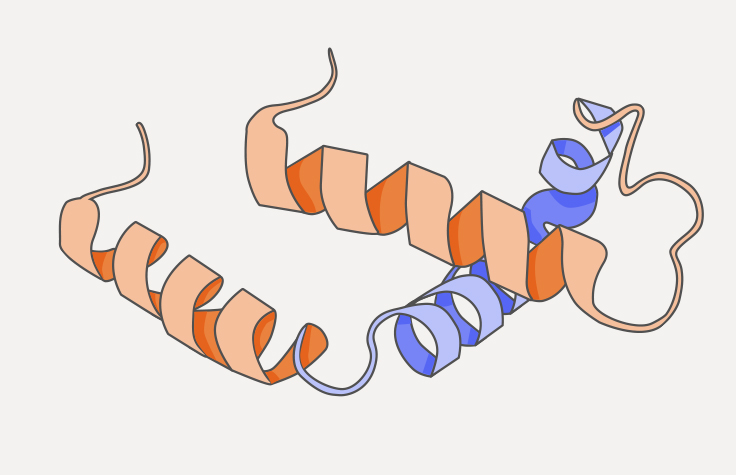Proteomics
Studying the structure and function of biological systems with proteomics
Explore the proteome with the power of NGS

What is proteomics?
Proteomics is a discipline aimed at studying proteins in a biological system. Through genomic information, transcriptomic activity translates genes that encode the sequence of amino acids to create proteins. This entire set of proteins in an organism, also known as the proteome, provides a complex, yet vital source of information about the structure and function of cells. Advancements in this area can provide ground-breaking discoveries to better understand diseases, biomarkers, and development of therapeutics.
Just as next-generation sequencing (NGS) revolutionized genomics and transcriptomics with unprecedented speed, accuracy, and scalability, this technology is now being applied to study proteins.
Analyzing proteomes with the power of high-throughput NGS
Identifying proteins is a primary goal in many proteomics applications. For example, this can include determining the presence or absence of an expected protein and identifying bioactive proteins. Combining proteomic methods with NGS allows users to analyze the proteome with the added power of cost-efficient scalability, flexible sample batching, high throughput protein discovery, and subsequent data integration for multiomics and proteogenomics.
Illumina enables proteomic discoveries
Illumina offers proteomic insights with Illumina Protein Prep, a solution that represents a significant advancement in high-throughput proteomics discovery by integrating our trusted sequencing by synthesis (SBS) chemistry with the high sensitivity of SOMAmer (slow off-rate modified aptamer) technology. Illumina is committed to advancing NGS-based multiomics solutions, and innovations like Illumina Protein Prep are vital in making these powerful tools more accessible to scientists across the globe.

Launch the next era of proteomics with Illumina Protein Prep solution
Unlock exceptional discovery power, market-leading performance, and integrated analysis to accelerate your next proteomics breakthrough on NovaSeq 6000 and NovaSeq X Systems.
How is proteomics used in multiomic profiling?
Detection and identification of proteins coupled with other omic techniques provide a comprehensive view of how cells function and their activity. Since many different proteins can come from a single gene, the full spectrum of analytical options provides a rich landscape of information for insights to identify targets and therapies for many areas of study.
A simultaneous approach to quantifying gene expression and protein
Scientists show a novel multiomic approach to simultaneously measure mRNA and protein expression in single cells, laying the groundwork to discover a never before seen subset of immune cells.
Complex dynamics revealed with genomics and proteomics in leukemia
Read how single-cell genomics can pair with protein measurements to reveal a clearer picture of leukemia tumor heterogeneity.
Human brain proteomes with genome-wide association data
Learn how the intersection of proteomics and genome-wide association data can team up to provide new insights into Alzheimer’s disease pathogenesis and therapeutic targets.
Combining genomic and proteomic data for cancer
Read this article on how proteogenomics is advancing the frontiers of oncology through a better understanding of tumor biology pathways.
Integrative molecular classification of meningiomas
Read this report to learn how multiomic data that contains matched multidimensional bulk and single-cell molecular and high-quality clinical data can define a molecular taxonomy for meningiomas and improve future grading schemes.

Explore the proteome with NGS
Learn more about how NGS can amplify proteomics discovery power and provide deeper insights into complex biological processes.
Featured proteomics workflow
Prepare Samples
Illumina Protein Prep
Illumina Protein Prep combines sequencing by synthesis chemistry with SOMAmer Reagents for a comprehensive NGS-based assay. The entire workflow is automated on the Illumina Protein Prep Automation System.
Sequence
NovaSeq X Series
Gain unprecedented scalability and sequencing depth for comprehensive multiomic projects.
NovaSeq 6000 System
Access robust, scalable sequencing for high-throughput applications.
Analyze
DRAGEN Protein Quantification
Integrated secondary analysis pipeline auto-launches after sequencing for complete normalization and protein expression quantification.
Illumina Connected Multiomics
Unlock deeper biological insights with a powerful omcis analysis software featuring interactive visualization and statistical analysis.
Additional resources
Multiplex high-throughput proteomics with analytical specificity
Read how to leverage Illumina sequencing systems to perform high-throughput protein profiling for biomarker and drug discovery studies in this tech note.
Spatial proteogenomics of FFPE tissue sections
This application note details methods to reveal the tissue architecture of astrocytoma and glioblastoma using the NanoString GeoMx Digital Spatial Profiler and Illumina NGS technologies.
Detect unique molecular signatures in Th1-polarized cells
Optimize bulk and single-cell sequencing to profile Th1 cells with Illumina NGS and BioLegend TotalSeq Antibodies.
Cancer-specific protein patterns of single cells
Download this application Note to learn how to simultaneously quantify and spatially map membrane proteins using Molecular Pixelation powered by Illumina NGS.
